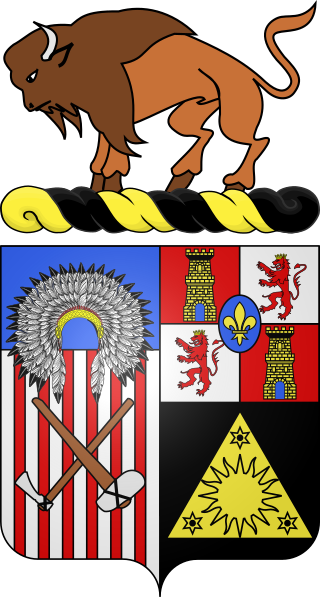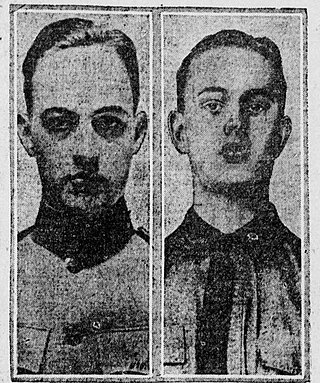Related Research Articles

The Pancho Villa Expedition—now known officially in the United States as the Mexican Expedition, but originally referred to as the "Punitive Expedition, U.S. Army"—was a military operation conducted by the United States Army against the paramilitary forces of Mexican revolutionary Francisco "Pancho" Villa from March 14, 1916, to February 7, 1917, during the Mexican Revolution of 1910–1920.

The Battle of Carrizal occurred on June 21, 1916. It was a major skirmish between United States Army troops of General John J. Pershing's Punitive Expedition and Carrancista troops fought at the town of Carrizal in the Mexican state of Chihuahua.

The 10th Cavalry Regiment is a unit of the United States Army. Formed as a segregated African-American unit, the 10th Cavalry was one of the original "Buffalo Soldier" regiments in the post–Civil War Regular Army. It served in combat during the Indian Wars in the western United States, the Spanish–American War in Cuba, Philippine–American War and Mexican Revolution. The regiment was trained as a combat unit but later relegated to non-combat duty and served in that capacity in World War II until its deactivation in 1944.

The Garza Revolution, or the Garza War, was an armed conflict fought in the Mexican state of Coahuila and the American state of Texas between 1891 and 1893. It began when the revolutionary Catarino Garza launched a campaign into Mexico from Texas to start an uprising against the dictator Porfirio Diaz. Because of this violation of neutrality, the United States Army became involved and assisted the Mexican Army in tracking down Garza's followers. The war was relatively minor compared to other similar conflicts in Mexican history though it has been seen as a precursor to the major Mexican Revolution from 1910 to 1920.
The Accusing Hand is a 1913 American short silent Western film directed by Romaine Fielding. It stars Fielding himself with Mary Ryan and Robyn Adair. The film was produced by and distributed by Lubin Manufacturing Company. The Accusing Hand was shot in and around Tucson, Arizona and featured locations on the University of Arizona Campus including South Hall, designed by architect Henry C. Trost of the firm Trost & Trost in 1899 and demolished in 1958.
The Uprising is a 1912 silent short film drama directed by Romaine Fielding for the Lubin Manufacturing Company.
The Family Next Door is a 1912 silent short film directed by and starring Romaine Fielding and with Mary Ryan.
The Way of the Mountains is a 1912 silent short film directed by Romaine Fielding and starring Mary Ryan. It was produced by the Lubin Manufacturing Company and distributed by the General Film Company.
Chief White Eagle is a 1912 American short silent Western film directed by and starring Romaine Fielding with Mary Ryan. It was produced by the Lubin Manufacturing Company and distributed by the General Film Company.
His Western Way is a 1912 American short silent Western film directed by Romaine Fielding. It stars Fielding himself and Mary Ryan. The film was produced by the Lubin Manufacturing Company and distributed by General Film Company.
The Power of Silence is a 1912 silent film drama short directed by and starring Romaine Fielding, with Mary Ryan and Robyn Adair. It was produced by the Lubin Manufacturing Company.
Courageous Blood is a 1913 silent film drama short directed by and starring Romaine Fielding. His costars were Mary Ryan and Robyn Adair. It was produced by the Lubin Manufacturing Company.
The Unknown is a 1913 silent film drama short directed, written by and starring Romaine Fielding with costars Mary Ryan and Robyn Adair. It was produced by the Lubin Manufacturing Company and released by General Film Company.
In the Land of the Cactus is a 1913 silent film short produced by the Lubin Manufacturing Company of Philadelphia. It was directed, written by and starring Romaine Fielding. Mary Ryan also costars. It is not to be confused with a 1911 American Film Company film of the same name.
The Man from the West is a 1914 American short silent Western film directed by Romaine Fielding. It also starred Mary Ryan and Robyn Adair. It was filmed in Silver City, New Mexico, produced by the Lubin Manufacturing Company and distributed by the General Film Company.
Pedro's Treachery is a 1913 silent film drama short directed by and starring Romaine Fielding and produced by the Lubin Manufacturing Company.
A Girl Spy in Mexico is a 1913 silent film short directed by and starring Romaine Fielding and costarring Mary Ryan. It was produced by the Lubin Manufacturing Company, Philadelphia, and distributed by the General Film Company.
The Reformed Outlaw is a 1913 American short silent Western film directed by Romaine Fielding and starring Mary Ryan, Robyn Adair and Jesse Robinson. The Lubin Manufacturing Company produced the film and General Film Company distributed. The film is not to be confused with the 1912 film of the same name produced by Thomas Ince.

The Candelaria border incursion of 1919 was a US military invasion of Mexico to find, engage and neutralize a Mexican bandit group led by Jesús Rentería. Rentería had kidnapped two United States Army Border Air Patrol pilots that had crashed south of the US-Mexican border and successfully ransomed them back to the United States.

Henry Rodney Adair (1882–1916) was an American cavalry officer. He is most notable for his participation in the Battle of Carrizal of the Pancho Villa Expedition.
References
- ↑ An Adventure on the Mexican Border at silentera.com
- 1 2 Brégent-Heald, Dominique (2015). Borderland Films: American Cinema, Mexico, and Canada During the Progressive Era. U of Nebraska Press. ISBN 978-0-8032-7884-4.
- ↑ Bernardi, Daniel; Green, Michael (July 7, 2017). Race in American Film: Voices and Visions that Shaped a Nation [3 volumes]. ABC-CLIO. p. 290. ISBN 978-0-313-39840-7.